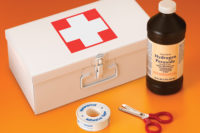Hospital disinfectant used to prevent infections may cause workers respiratory, eye symptoms

Hospital workers who used a disinfectant reported more incidents of work-related wheeze and watery eyes than those who did not use the product, reports a National Institute for Occupational Safety and Health (NIOSH) study published in the American Journal of Infection Control. The study was performed through the NIOSH Health Hazard Evaluation Program after workers expressed concerns about the disinfectant. This free NIOSH program is available to help employers and workers recognize and control work-related hazards.
Safety of patients v. hospital workers
Hospital-acquired infections are a growing problem in U.S. hospitals. As the number of antibiotic-resistant infections rises, prevention is imperative and requires disinfecting patient-care areas and medical equipment. At the same time, exposure to chemicals in cleaning products, through the skin or by breathing in vapors, can worsen asthma and other respiratory symptoms among workers. Subsequently, infection prevention in a hospital requires a balance between protecting the safety and health of patients and hospital workers.
For this study, researchers focused on a disinfectant containing the chemicals hydrogen peroxide, peracetic acid, and acetic acid. Through in-person interviews, they asked 163 hospital employees about their work, use of the disinfectant, and health. For comparison, they included hospital workers who used the disinfectant and those who did not, but who worked in areas where others used it. They considered work-related symptoms, such as wheezing and watery eyes, as well as those that improved when the workers were away from the hospital. In addition, they tested 49 air samples in different locations of the hospital for the three chemicals found in the cleaning product.
More likely to have asthma
Results showed that hospital workers who used the disinfectant reported more incidents of work-related wheeze and watery eyes than those who did not use the disinfectant. Workers in the areas with the highest air measurements of the disinfectant chemicals were significantly more likely to report watery eyes, compared to those in areas with lower air levels. Compared to people in the general U.S. population, workers in the areas with the highest air concentrations were more than three times as likely to have asthma. There was no significant difference in asthma rates, however, between workers who used the disinfectant and those who did not.
Air concentrations of hydrogen peroxide and acetic acid were below national guidelines for exposure limits. At this time, there is no recommended or permissible exposure limit for peracetic acid. Air sampling results observed the highest average air concentrations for all three chemicals in the labor and delivery department.
A study limitation is that the air samples tested only for three chemicals, so it is possible that other chemicals could have caused some of the reported symptoms. Another limitation is the use of self-reported symptoms, which could be subject to recall or reporting bias. Still, the findings underscore the importance of following cleaning procedures that protect workers’ as well as patients’ health, the researchers said. To do that, they made several recommendations:
- Workers should use the product sensibly and minimize the product’s use in areas where the risk of acquiring a hospital-acquired infection is low. General cleaning is sufficient in non-patient care areas.
- Workers should report any work-related health symptoms to the hospital’s occupational health department, ideally via an anonymous reporting system.
- The hospital should reassign workers experiencing symptoms to an area in the facility with little to no exposure to the product.
- Workers should receive training about the potential health hazards of cleaning and disinfectant products and proper protection.
More information is available:
Looking for a reprint of this article?
From high-res PDFs to custom plaques, order your copy today!





